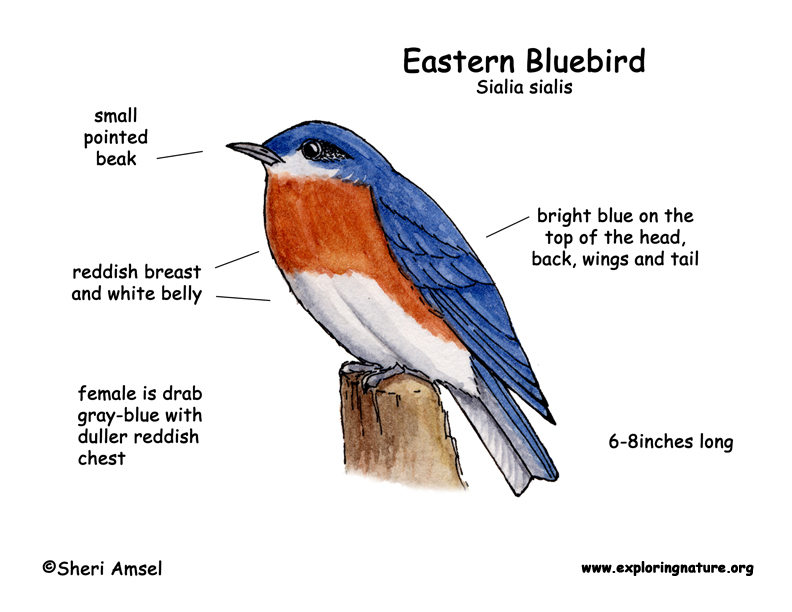

They spend the winter from Kansas to Connecticut and south. They are also in New Mexico and west Texas. They breed in the eastern U.S. and Canada, south to Texas and Florida, Arizona through central Mexico and Nicaragua.
They are found in open woodlands, fields, and farms.
They are bright blue above with a reddish breast and white belly. The female is drab gray-blue with duller reddish chest. They are 6-8 in long.
Bluebird pairs arrive in the spring to nest and will use the same nest box from year to year. They can be quite aggressive toward other birds (swallows or sparrows) that try to use their nest box or nest boxes nearby.
They sit up on a high perch to hunt for insects.
They nest in tree cavities, weaving a nest of grass or pine needles, lined with grass, hair, or feathers. They lay 3-7 pale blue to white eggs. If available, they will nest in bird boxes and will defend the boxes from other birds trying to nest there (and sometimes nest in nearby boxes). Bluebird parents both bring food to their chicks. Young from earlier broods may also helps feed the new chicks. Bluebirds may have two and sometimes three broods of chicks.
Kingdom: Animalia
Phylum: Chordata
Subphylum: Vertebrata
Class: Aves
Order: Passeriformes
Family: Turdidae
Genus: Sialia
Species: S. sialis
When you research information you must cite the reference. Citing for websites is different from citing from books, magazines and periodicals. The style of citing shown here is from the MLA Style Citations (Modern Language Association).
When citing a WEBSITE the general format is as follows.
Author Last Name, First Name(s). "Title: Subtitle of Part of Web Page, if appropriate." Title: Subtitle: Section of Page if appropriate. Sponsoring/Publishing Agency, If Given. Additional significant descriptive information. Date of Electronic Publication or other Date, such as Last Updated. Day Month Year of access < URL >.
Amsel, Sheri. "Bluebird (Eastern)" Exploring Nature Educational Resource ©2005-2024. December 13, 2024
< http://www.exploringnature.org/db/view/Bluebird-Eastern >

